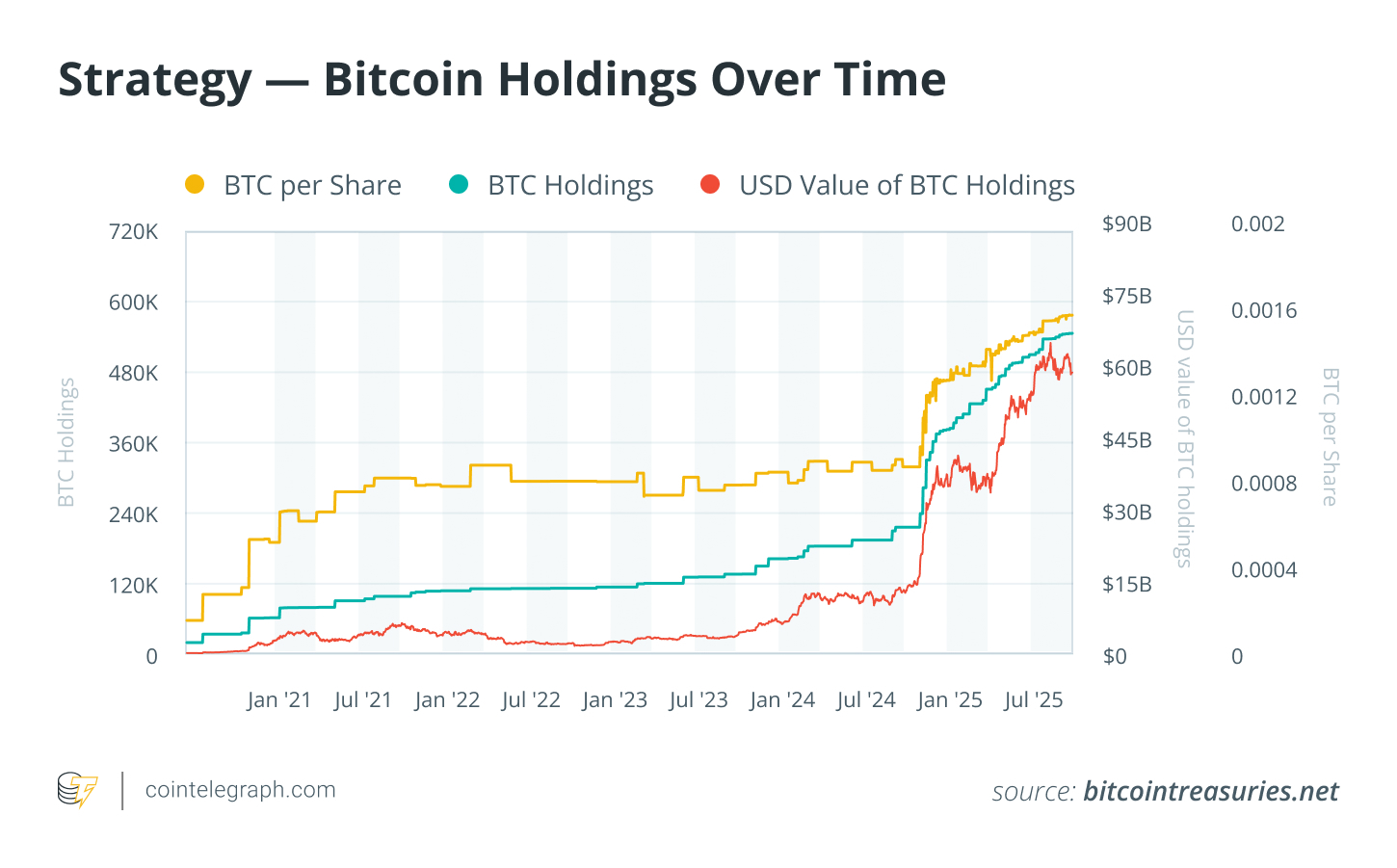
Unpacking Saylor's Ongoing Bitcoin Accumulation Strategy
An exploration of Michael Saylor’s long-term vision for Bitcoin as a treasury asset and the strategies employed by his company, Strategy.
Saylor’s Bitcoin Strategy
Michael Saylor strives to revolutionize corporate finances.
Since August 2020, Michael Saylor’s firm, which has transitioned from MicroStrategy to Strategy, is among the top public owners of Bitcoin (BTC). As of September 2025, this company had acquired 640,031 BTC, valued over $73 billion. The average purchase price is in the high tens of thousands, granting the company significant unrealized gains at current price levels.
Saylor perceives Bitcoin as both a safeguard against inflation and a non-depreciable asset, positioning his company advantageously for anticipated institutional investments. His intriguing theory suggests that if Wall Street allocates even 10% of its assets to Bitcoin, the price could escalate towards $1 million.
 Bitcoin Strategy
Bitcoin Strategy
Did you know? MicroStrategy’s inaugural Bitcoin purchase for its corporate treasury took place in August 2020, costing $250 million.
Bitcoin as an Ideal Treasury Asset
Saylor’s method is clear and persistent: accumulate Bitcoin, indefinitely hold it, and integrate it within the company’s framework.
Since 2020, Strategy has converted surplus cash, leveraged debts, and equity funding into a consistent stream of Bitcoin buys. Presently, the company comprises 640,031 BTC (around 3% of total Bitcoin supply) with an average purchasing price of roughly $73,983 per coin.
Rather than treating volatility as a danger, Saylor views it as a chance — buying during price drops, enduring market fluctuations, and allowing Bitcoin’s scarcity to function over time.
He contrasts Bitcoin against cash, describing it as a “melting ice cube” due to inflation diminishing its worth. Bitcoin, with a fixed cap of 21 million coins, is regarded as a more resilient alternative to gold, which is costly to store and authenticate.
He also sees Bitcoin serving as a diversification asset, particularly as its correlation with stocks and bonds has weakened, providing hedge-like benefits in inflation-prone environments.
The Path to $1 Million: Explaining Saylor’s Bitcoin Vegas Projection
Saylor asserts that Bitcoin might ultimately reach $1 million per coin.
This assumption initiates from institutional capital; groups such as pension funds and asset managers control over $100 trillion. A mere 10% allocation (around $10 trillion to $12 trillion) into Bitcoin would lead to remarkable price impacts.
Such demand, based on Bitcoin’s fixed supply of 21 million coins, would suggest a near valuation of $475,000 per BTC. Nevertheless, Saylor points out that the actual supply is likely lower due to several million BTC being permanently lost or held without movement for many years.
The recasting of a liquid supply ranging from 16 million to 18 million BTC could lift the implied price to between $555,000 and $750,000 given the same institutional allocation.
How Strategy Finances its Bitcoin Purchases
Over recent years, Strategy has heavily relied on varied financial instruments to sustain its BTC acquisitions.
Convertible notes are foundational, allowing conversion into equity under specific terms, often with minimal interest rates. Recently, Strategy raised $800 million via a convertible note offer, buying 11,931 BTC at an average price of $65,883.
Preferred stock issuance has also been pivotal for financing, showing substantial investor demand.
Risks, Critiques, and Future Observations
As the largest corporate Bitcoin holder, Strategy’s growth presents several challenges.
While its stock price closely follows Bitcoin’s movements, there’s a risk for existing shareholders due to the dilution from funding new Bitcoin purchases via equity or convertibles. Analysts highlight:
- Regulatory risk: Possible changes in tax and accounting could weaken the rationale for BTC holdings.
- Opportunity cost: Significant resources are tied in a volatile asset.
- Demand uncertainty: The $1 million forecast depends on Wall Street hitting the 10% allocation goal.
Nevertheless, Strategy’s influence on corporate adoption of Bitcoin is profound, leading to expanded growth in custody services and related investment vehicles.
Keep an eye on:
- Future capital generation and funding models
- Regulatory clarity on Bitcoin accounting
- Signs large asset managers transferring assets into Bitcoin.
If these patterns materialize, Saylor’s strategy could transform both corporate financial policies and Bitcoin’s standing in the global finance arena.



